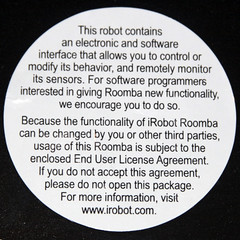 I’ve had my Roomba for a couple of weeks now, and so far I am impressed. I’m impressed how well it finds its way around. I’m impressed with how well it actually cleans. But perhaps I was most impressed by iRobot as a company.
I’ve had my Roomba for a couple of weeks now, and so far I am impressed. I’m impressed how well it finds its way around. I’m impressed with how well it actually cleans. But perhaps I was most impressed by iRobot as a company.
My first clue was that the schematic diagram of the Roomba in the manual included a description of where the serial port was. I had to double take. In all my dealings with consumer electronics in the Wi-Fi space, we’ve had to jump through hoops to get access to a serial port on a production device. In one case we had to add surface mount zero ohm resistors (anybody remember when these were just links?). And here’s a device that not only has the port accessible, but it is labelled in the user manual.
Then I found the sticker on the already opened bag. A EULA for a device? Surely not, but reading more I found: “For software programmers interested in giving Roomba new functionality, we encourage you to do so.” Now that is an enlightened company.
It is this kind of willingness to let others, including your end users, extend and improve your product that defines Web 2.0 and Mobile 2.0. Although most Roomba vacuuums are not connected to the internet, they are application specific devices, and they have an API and documentation for developers. If more consumer electronics devices came with this level of support for user experimentation the world might just be a little bit better off.
On the subject of Web/Mobile 2.0, I will be co-presenting a session about Mobile 2.0 on behalf of Devicescape at the Web 2.0 Expo this week. You can read more about that on the Devicescape Blog 2.0.
